2012 |
||
Something
new has been added! During sculpting week in Breckenridge, our artists do their best work with shovels and snow. To highlight that work, an eco-friendly LED lighting system will illuminate the outdoor sculpture gallery. Throughout the viewing week subtle colors add tothe artistry, creating a dance of light and snow |
||
| The Championships
are held in and around the Riverwalk Center, located in the heart
of Breckenridge
on South Park Avenue between Washington Street and Adams Avenue. |
||
TEAM CANADA / QUÉBEC
“Great Expectations” 1st Place People's Choice Artist's Choice |
In the 1930’s, “ice
houses” were essential for the preservation of meat, poultry
and fish. On the Saint Anne River in central Quebec, Canada, ice
was sawn from the frozen river to furnish the many ice houses
in the region. It was during this ice harvest that millions of small fish, know as Tommycod, were discovered swimming upstream to spawn in the waters under the ice. Soon after this discovery, hundreds of people began making their way each winter to the mouth of the Saint Anne River, by train, or by horse and sleigh, just for the ice fishing. Today, in mid December, the inhabitants of the region install row after row of small heated fishing huts on the river ice, where thousands of visitors can enjoy the pleasures of Winter-time fishing. |
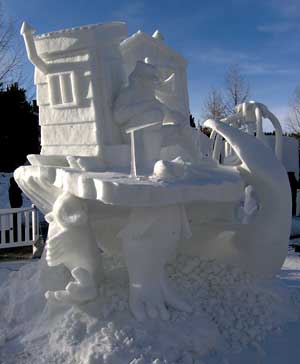 |
“Dancing Screens” 2nd Place
|
Th is snow sculpture symbolizes the various views, positions
and |
 |
TEAM BALTIC “Discover the Edge of the World” 3rd Place
|
This sculpture tells a story of courage and
curiosity. This epic tail recounts the story of the kings, who went and returned from the edge of the world, showing people that anything is possible, and only our minds limit our actions. |
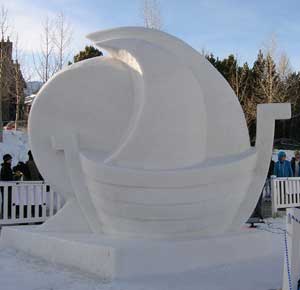 |
|
“Teh Deadliest Catch: Calmari's Revenge, the Kraken” Kid's Choice |
Wrapped in the tentacles of a legendarily
Kraken, a raider of the deep seeking plunder is transformed from predator to prey. Kraken: A sea monster of colossal proportions. Feeds on whales, ships, and men. Kraken attracted sea life; fishermen returning with an enormous catch were said to have ‘fished over Kraken’. This work juxtaposes man’s insatiable drive to overharvest nature’s bounty with the presupposition that nature will respond with cataclysm. What we really mean to say is, SOS, save our seas! |

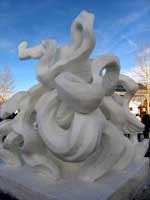 |
TEAM AUSTRALIA - USA “Temple of the Seasons” |
A melting snowman, desperate for just a bit
more winter, has journeyed to the ancient Temple of the Seasons to plead for colder temperatures. This lighthearted piece expresses the serious concerns we all share about climate change - and reminds us that we can do something about climate change now, before we find ourselves in the snowman’s sad state. |

|
“Ode to NASA” (Mother of a nation)
|
Th e space shuttle Atlantis blasts off for the last time. Over the years NASA has provided mankind with breathtaking discoveries, huge jumps in technology, and sometimes incredible tragedy. This piece expresses our gratitude to their dedication to discovery and science. The December launch to the International Space Station only clears the way for new advances and discoveries. Thanks NASA, we will never forget. |
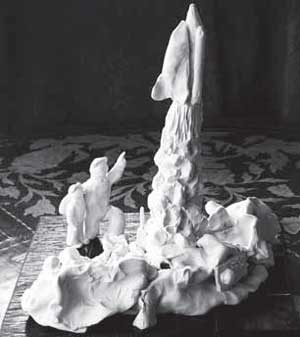 |
| TEAM CANADA / YUKON “Throat Singers” |
During the construction of a large inukshuk,
family members stop to celebrate with drum dancing and a throat
singing lesson. The inukshuk may have been used for navigation,
as a point of reference, a marker for travel routes, fishing places,
camps, hunting grounds, places of veneration, as drift fences
used in hunting or as a food cache. The Inuit in northern Alaska
used inukshuk to assist in the herding of caribou into contained
areas for slaughter. Inuit throat singing or katajjaq,
is a form of musical performance uniquely found among the Inuit.
Throat singing is a type of traditional competitive song, considered
a game, usually held between two women. When competing, two women stand face-to-face and sing using a complex method of following each other, thus that one voice hits a strong accent while the other hits a weak, melding the two voices into a nearly indistinguishable single sound. They repeat brief motifs at staggered intervals, often imitating natural sounds, like those of geese, caribou or other wildlife, until one runs out of breath, trips over her own tongue, or begins laughing, and the contest is then over. Th e old woman who teaches the children corrects sloppy intonation of contours, poorly meshed phrase displacements, and vague rhythms exactly like a Western vocal coach. |
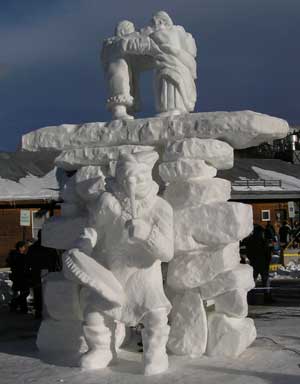 |
TEAM
CATALUNYA (CATALONIA-SPAIN) “Correfoc” |
Correfoc or “fi re-runs”
are among the most striking features present in Catalan festivals. In the correfoc, a group of individuals will dress as devils and light fireworks. While dancing to the drums of a traditional gralla, they will set off their fireworks among crowds of spectators. Th e correfoc can come in many forms. Some are simple parades using fireworks and effigies of the devil or dragons. |
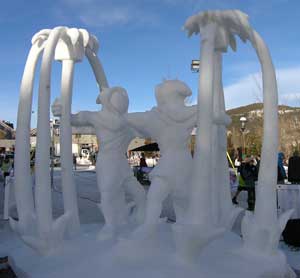
|
TEAM
CHINA
“Wrestle” |
This is sculpture of ancient Mongolian-style wrestling. |
 |
TEAM
FINLAND
“Giant Hogweed” |
It is giant and it looks nice. If you touch
it in sunlight, it is poisonous. It spreads everywhere if you
are not paying attention... |
 |
TEAM GREECE - USA / IDAHO “First Catch” |
During the first fishing lesson, a young Grizzly
Bear shows his aptitude while visiting Greek waters. |
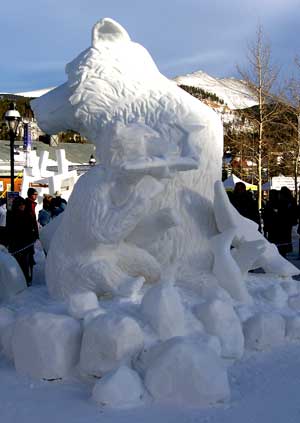 |
TEAM
MEXICO
“Satyagraha” |
Diversity
is fundamental part of human nature. Despite many thoughts, many
actions, and manifestations of human conditions, one thing remains:
The human spirit. Our sculpture represents the human spirit inside
a kind of a human being with four arms, no hands, and two faces.
The term “satyagraha” was conceived and developed
by Mahatma Gandhi. He deployed satyagraha in the Indian independence movement and also during his earlier struggles in South Africa. |
 |
TEAM
SWITZERLAND
“Endless” |
Endless..... Everything comes back to the start. When are you exploring and discovering the lines and edges, you will end at the start. And this will astonish you, even though you were expecting it. Life is turning and twisting and will do so for each generation. Endless..... |
 |
TEAM
USA / BRECKENRIDGE
“Fun Everytime Around” |
“As
our world keeps turning, we need to just sit back and enjoy the
ride!” |
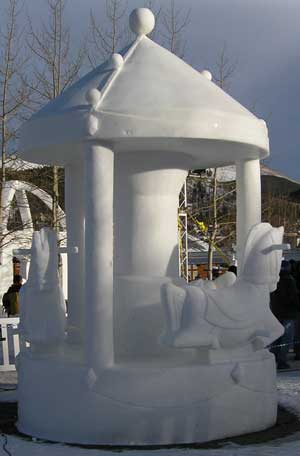 |
TEAM
USA / WISCONSIN (FRANKLIN)
“Al” |
Our concept for Breckenridge in 2012 is “Ai”
and is based on Japanese lore. According to Japanese legend, if
a koi fish succeeds in climbing the falls at a point called Dragon
Gate, it would be transformed into a dragon. The two koi up the
falls represent ”Ai” or love for all things. Their
climb together symbolizes aspiration, strength and determination. |
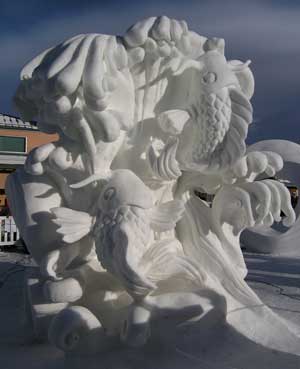 |